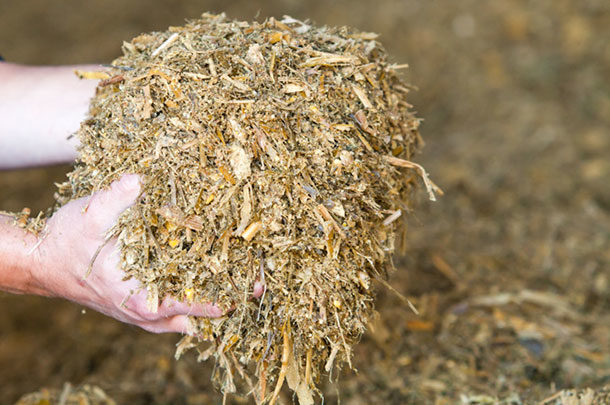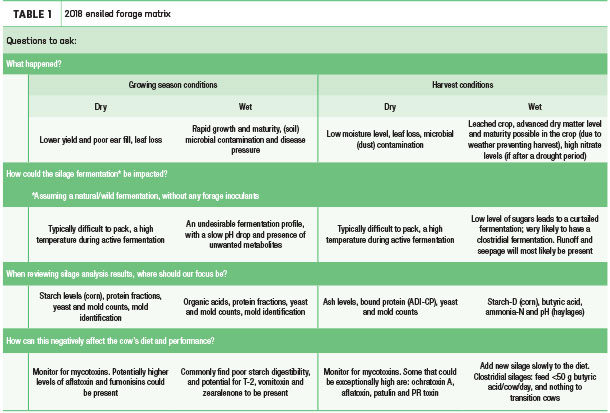Other parts of the region had an uncharacteristically cool spring, with some sown crops needing replanting, which in turn led to a late harvest.
At the other end of the spectrum, some areas experienced drought and high temperatures. Year after year, these “out of the norm” seasons seem to be more typical and are impacting the way we harvest, put up and assess our silages.
As we start to prepare to feed out the silages from this growing season, we need to understand the types of stress our crops were under and how we can ensure our cattle are fed the best way possible to minimize potential issues and achieve, or get as close as possible to, our performance goals.
The initial question to ask is, “How did the weather impact the chemical composition and nutritive value of each silage crop?” The answers will depend on:
1. The type of crop
2. The growth stage and management at harvest
3. The intensity and length of exposure to environmental challenges (moisture and temperature)
4. Changes in soil fertility
5. Weed infestations, insect or fungal attacks, or other damage
Weather effects during the growing phase
Seasonal weather influences during the crops’ growing phase will have some generally predictable effects. All other factors being equal, temperature is the driving force behind physiological processes in the plant and will have the greatest influence over yield and quality than any other environmental factor.
High temperatures during growth generally produce less digestible forage with higher lignin and fibre levels, and lead to faster maturity, a lower leaf-to-stem ratio and low soluble sugar levels. This will apply to both grasses and legumes, and goes a long way toward explaining differences between first-cut alfalfa and subsequent cuttings through the season.
With corn silage, prolonged high temperatures of 32ºC or greater, along with excess soil moisture, can reduce fibre digestibility and possibly grain yield, but not grain quality. Conversely, cooler weather slows plant growth down, leading to a higher leaf-to-stem ratio, a higher crude protein level than average and an overall more digestible forage.
Prolonged wet weather at any temperature depletes the soil of oxygen, resulting in reduced yield. Naturally occurring lactic acid bacteria populations on the plant have been found to be higher during warm, humid conditions, or following rain, with low counts reported during cold weather conditions.
The weather before and after silking can have a pronounced effect in the resulting silage. Dry conditions before silking favour enhanced stover neutral detergent fibre digestibility (NDFd) but can negatively affect the uniformity of pollination, whereas wet conditions before silking favour plant yield but lower fibre digestibility and, after silking, negatively affect grain yield.
Weather effects during harvest
Weather effects during harvest have a big influence on the final quality of the ensiled forage. In wet weather conditions, it may not be possible to enter the field, let alone provide an adequate window of time for swathing and chopping.
In wet weather, expect soil contamination from many different sources during the full harvest process. Be ready for higher ash values and the risk of unwanted clostridial or enterobacteria contamination. Furthermore, if any swaths got rained on before pick-up, a significant amount of soluble nutrients may have leached out, especially sugars.
These field losses have been estimated to range from 2 to 12 percent of total dry matter in the crop and will in consequence leave a less digestible crop for ensiling and directly impact forage fermentation.
Any leachate loss (from forages ensiled too wet due to weather conditions) will further increase the loss of soluble, highly digestible nutrients (sugars, organic acids and soluble-N, and soluble minerals) from the crop.
Prolonged wet weather conditions around harvest made achieving optimal corn silage dry matter very difficult. Early harvests would be expected to be too immature and low in starch (energy).
Those who waited to harvest may have dry matter levels 40 percent and above, requiring very good kernel processing to allow adequate access to the starch energy.
Dry, low humidity weather conditions at harvest provide a different set of challenges. Dust contamination and higher ash values can be expected.
Furthermore, plants in the swath could dry too quickly, be prone to digestible leaf shatter and be more difficult to pack in the silo. These factors individually, or combined, will all reduce the resulting silage yield and quality.
Crops ensiled at low ambient temperatures may not ferment well and sometimes will not ferment at all. As spring approaches and temperatures rise, only the outer layers of silage might ferment, making a very inconsistent and spoilage-prone silage (due to lack of organic acids).
Sampling and analyzing 2018 ensiled forages
There can never be one “typical” profile of an ensiled forage crop from such a variable growing season. Regardless of the ensiled forage type, a good representative sample should always be taken and sent for analysis, taking care to minimize microbial activity during handling and shipping. Moreover, it could be prudent to run the first sample through wet chemistry, even though this will take a little longer to get results.
There are some routine analysis parameters such as dry matter, pH, crude protein, acid detergent fibre (ADF), neutral detergent fibre (NDF), NDFd, associated digestibility rate value (kd), starch content and digestibility, and ash that will be crucial to review.
With all the variability of forages, a full fermentation profile is especially recommended this year along with careful analytical insight and interpretation.
Working alongside your nutritionist, Table 1 can be helpful with assessing, reviewing and making a feeding plan for the 2018 ensiled forages.
Click here or on the image above to view it at full size in a new window.
Ways to move forward
Make sure the farm team is analyzing and testing the ensiled forages.
Make sure the farm team is following the recommended silage management tips – silos are sealed and covered, visual inspection takes place, good feedout management (adequate feedout rates and proper silage face management) and ensuring safety of personnel during silage removal and feedout.
Along with your nutritionist, come up with a feedout plan, especially with challenged silages. Consider using feed additives in the diet that help optimize rumen performance and those that help maintain lower gut health, especially if high levels of molds and mycotoxins are present.
For next season: Coordinate the silage harvesting and farm team to achieve the best given weather and growing season – monitor the field and coordinate harvesting, inoculation and packing accordingly. ![]()
PHOTO: Silage varies from season to season based on a number of factors and must be analyzed for nutritional value. Photo courtesy of Lallemand Animal Nutrition.
Anthony Hall is a technical services dairy expert at Lallemand Animal Nutrition.
Bob Charley is forage products manager at Lallemand Animal Nutrition.

-
Renato Schmidt
- Forage Products Specialist
- Lallemand Animal Nutrition
- Email Renato Schmidt












